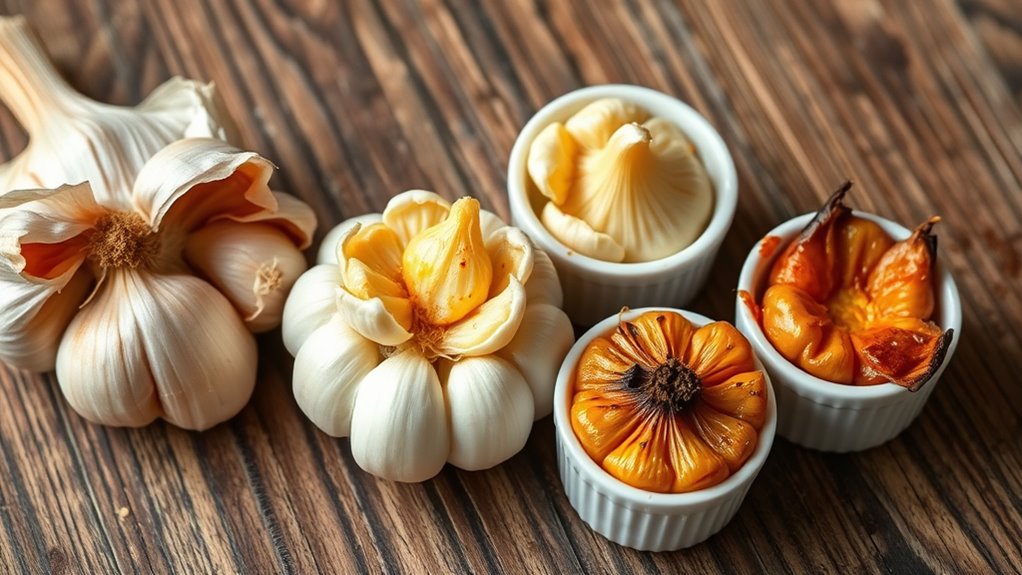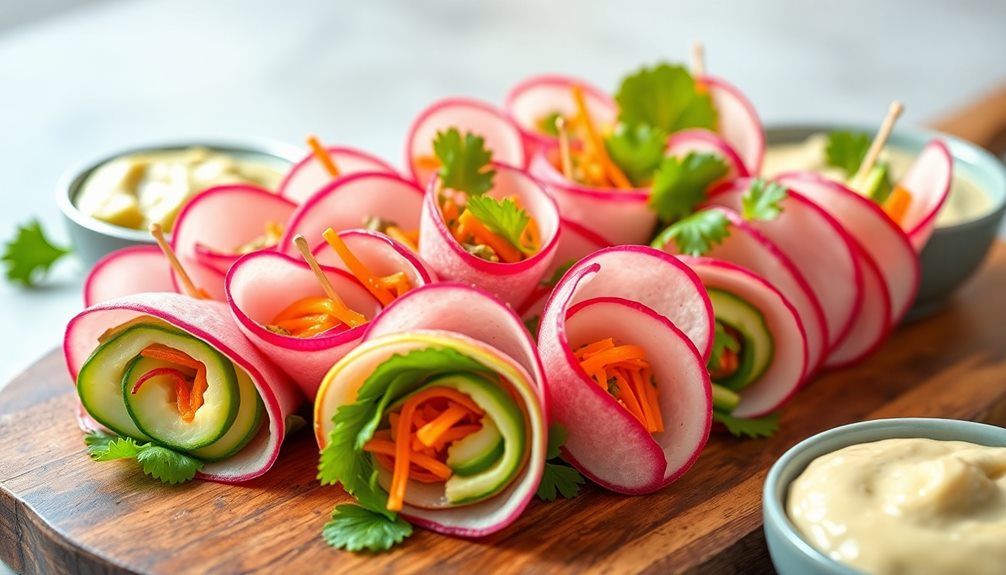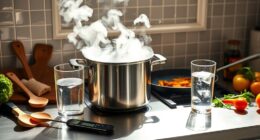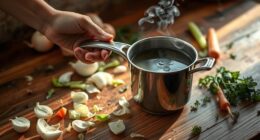To roast garlic without losing nutrients, start with fresh bulbs and slightly crush or chop the cloves to activate beneficial enzymes. Wrap whole garlic heads in foil and roast at 375°F (190°C) for 30-40 minutes, turning once, to develop flavor while preserving health benefits. For quicker options, cut garlic into halves or quarters, toss with olive oil, and roast at 400°F (200°C) for 15-20 minutes; or use a slow cooker at low heat for 2-3 hours. Exploring these methods helps maximize your garlic’s goodness.
Key Takeaways
- Start with fresh garlic and slightly crush or chop cloves to activate enzymes, preserving health benefits during roasting.
- Use gentle roasting methods like wrapping in foil at 375°F for 30-40 minutes to prevent nutrient loss.
- For quicker roasting, cut garlic into halves or quarters, toss with olive oil, and roast at 400°F for 15-20 minutes, monitoring closely.
- Consider slow cooking whole bulbs on low heat for 2-3 hours to minimize nutrient degradation.
- Avoid overcooking and high temperatures to maintain beneficial compounds like allicin and ensure maximum nutrient retention.
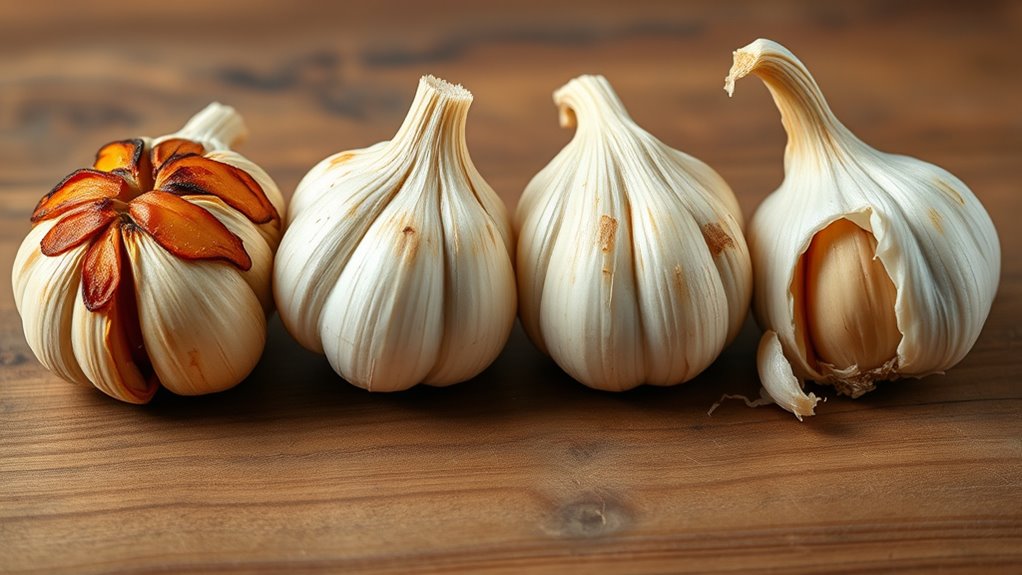
Roasting garlic enhances its natural sweetness and mellow flavor, making it a versatile addition to many dishes. When you roast garlic properly, you not only develop its rich, caramelized taste but also preserve its impressive garlic health benefits. Garlic is known for its potential to boost your immune system, lower blood pressure, and reduce inflammation, thanks to compounds like allicin. To maximize these benefits, it’s essential to understand effective roasting techniques that retain nutrients while delivering that signature sweet, mellow flavor.
Start with fresh garlic bulbs, and before roasting, consider crushing or chopping the cloves slightly. This activates enzymes that release beneficial compounds, ensuring you get the full garlic health benefits. When it comes to roasting techniques, the key is controlling heat and timing. For gentle roasting, wrap whole garlic heads in foil and place them in a preheated oven at about 375°F (190°C). Roast for 30-40 minutes, turning once, until the cloves are soft and golden. This method conserves nutrients because the relatively moderate temperature prevents nutrient breakdown, and the foil minimizes moisture loss.
For gentle roasting, wrap garlic heads in foil at 375°F for 30-40 minutes to preserve nutrients and develop flavor.
If you prefer a quicker method, you can cut garlic into halves or quarters, toss it in a little olive oil, and roast on a baking sheet at 400°F (200°C) for 15-20 minutes. Keep an eye on it to prevent burning, which can degrade some nutrients and produce bitter flavors. For even more control, you could use a toaster oven or a cast-iron skillet on the stove. Just keep the heat moderate, and cook until the garlic is tender and lightly caramelized. This approach allows for more precise temperature management, helping you retain maximum nutrients and garlic’s health benefits. Incorporating proper roasting techniques can further help preserve garlic’s bioactive compounds and maximize health benefits.
Another popular technique involves roasting garlic in a slow cooker or crockpot. This method is gentle and ensures even heat distribution, which helps preserve nutrients and flavor without risking overcooking. Simply place whole garlic bulbs in the slow cooker on low for 2-3 hours until soft. While slower, it’s a hands-off approach that minimizes nutrient loss due to lower temperatures. Additionally, using proper storage methods can help maintain garlic’s potency before roasting.
No matter which roasting technique you choose, avoid overcooking. Excessive heat can destroy some of garlic’s beneficial compounds. The goal is to develop a sweet, mellow flavor while maintaining as many nutrients as possible. By understanding these roasting techniques, you’ll enjoy delicious, healthful garlic that enhances your meals and supports your well-being.
Frequently Asked Questions
Can Roasted Garlic Be Stored Long-Term Without Nutrient Loss?
Roasted garlic can be stored long-term without losing nutrients if you use proper garlic storage techniques. To preserve nutrient content, cool the roasted cloves completely before sealing them tightly in an airtight container. Keep the container in the refrigerator or freezer, with the freezer being ideal for extended storage. This approach helps prevent nutrient degradation, keeps the garlic fresh, and maintains its flavor, ensuring you enjoy its health benefits over time.
Is There a Difference in Nutrient Retention Between Raw and Roasted Garlic?
When comparing raw and roasted garlic, you’ll notice differences in garlic flavor and garlic texture. Raw garlic retains more nutrients because it’s not exposed to heat, which can diminish some vitamins. Roasted garlic offers a sweeter, milder flavor and softer texture but may lose certain nutrients during cooking. If you want maximum nutrient retention, enjoy raw garlic; for a richer flavor and softer texture, roasting is your best choice.
Which Roasting Method Preserves the Most Antioxidants in Garlic?
You want to know which roasting method preserves the most antioxidants in garlic. To do this, keep the garlic peel on during roasting, as it helps protect nutrients. Use a lower roasting temperature to minimize nutrient loss and prevent overheating. This gentle method maintains more antioxidants, ensuring you get the health benefits. So, roasting at a moderate temperature with the peel on is your best bet for nutrient retention.
How Does Roasting Garlic Impact Its Mineral Content?
Imagine garlic’s minerals as tiny treasures hiding inside each clove. Roasting garlic impacts its mineral content, but if you roast gently, you can preserve most of its garlic mineral content. The roasting nutrient impact is mainly minimal, as high heat can cause some mineral loss. To maximize garlic’s mineral preservation, avoid overcooking. You keep those precious minerals intact, ensuring you enjoy all the health benefits with every roasted bite.
Are There Specific Tips to Maximize Flavor While Maintaining Nutrients?
To maximize flavor enhancement while maintaining nutrient preservation, you should roast garlic at moderate temperatures and avoid overcooking. Use foil wraps or parchment paper to lock in moisture and nutrients, and keep a close eye on roasting times. Incorporate herbs or spices during roasting for added flavor without compromising nutrients. These tips help you enjoy rich, flavorful garlic that retains its health benefits.
Conclusion
Now that you’ve mastered four ways to roast garlic without losing its nutrients, you hold the key to revealing rich, flavorful dishes. Just as the alchemist transforms simple ingredients into gold, your gentle approach brings out garlic’s true essence. Remember, with patience and care, you can elevate everyday meals into something extraordinary. Embrace these methods, and let your culinary journey be a proof to the magic that happens when tradition meets innovation.
